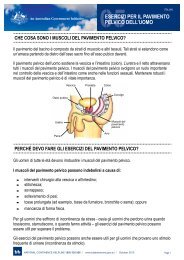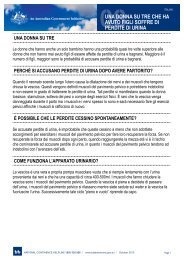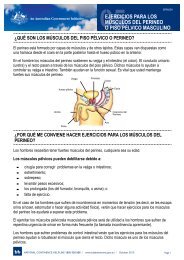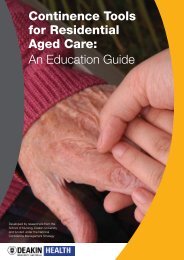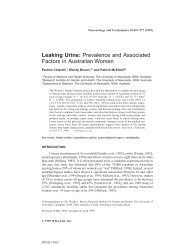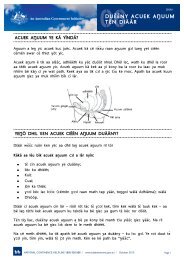Pharmacy Continence Care - Bladder and Bowel Website
Pharmacy Continence Care - Bladder and Bowel Website
Pharmacy Continence Care - Bladder and Bowel Website
Create successful ePaper yourself
Turn your PDF publications into a flip-book with our unique Google optimized e-Paper software.
period with a national recruitment <strong>and</strong> participation target of 1000 community pharmacies,<br />
covering all metropolitan areas, all regional centres, <strong>and</strong> rural <strong>and</strong> remote communities.<br />
5.1.3 Funding of the Program<br />
Stage 1 of the program was funded by the Australian Government under the National<br />
<strong>Continence</strong> Management Strategy. Stage 2 projects of the PCCP were funded by the<br />
Australian Government under the Third Community <strong>Pharmacy</strong> Agreement Research <strong>and</strong><br />
Development programs. As research <strong>and</strong> pilot projects, the cost per pharmacy of the<br />
Program to date is substantial. The two projects have provided the complement of evidencebased<br />
training materials, evaluated training methods, <strong>and</strong> pharmacy <strong>and</strong> consumer benefit<br />
measures, <strong>and</strong> these are now capable of continuing use at production <strong>and</strong> distribution costs<br />
only. All materials except the flip chart are available for download from the internet.<br />
The outcome of the pilot Program indicates that funding requirements for the Program to<br />
continue on a national roll-out basis would primarily reflect the cost of materials <strong>and</strong> groupbased<br />
training. Table 3 indicates the cost per unit of each of the pilot-evaluated materials<br />
<strong>and</strong> of group-based training. Self-paced training incurs no cost to the Program other than<br />
Program administration. Table 3 also provides costings for delivery of the Program assuming<br />
1000 units (materials <strong>and</strong> individuals trained).<br />
Implementation of the Program is proposed as a two-year trial. For the purposes of<br />
identifying the cost of a national roll-out, the project team has used a target participation<br />
rate of up to 1000 staff of community pharmacies across Australia. The funding requirement<br />
to achieve national roll-out with this goal comprises:<br />
• material <strong>and</strong> resource provision: $52,800 (inc GST)<br />
• group-based training to a maximum of 1000 individual participants: $220,000<br />
• Program administration: $200,200.<br />
Therefore, the Program total funding requirement, assuming a target participation rate of<br />
1000 individual participants, is $473,000 over two years. A contingency factor is<br />
recommended, at 7-10 per cent of total cost, which would result in a full Program provision<br />
of $530,000, assuming participation of 1000 pharmacy staff through the two year Program.<br />
As discussed, funding options include full funding by government through an appropriate<br />
program, or user-pays for participating pharmacies. The Program could be fully funded by<br />
government through the National <strong>Continence</strong> Management Strategy or its successor. Full<br />
cost recovery would require a fee for participation, training <strong>and</strong> review of $530 per<br />
participating pharmacy. The incurred cost (staff time) per pharmacy of participating in the<br />
training was reported (see Section 4.2.8) at an average of $150, making the full cost of<br />
participation in the Program for each pharmacy a total of $680.<br />
Final Report<br />
50<br />
NOVA Public Policy<br />
<strong>Pharmacy</strong> <strong>Continence</strong> <strong>Care</strong> Project



